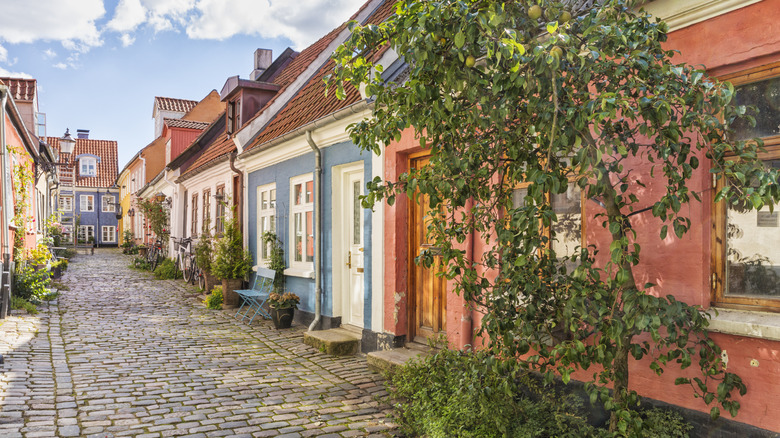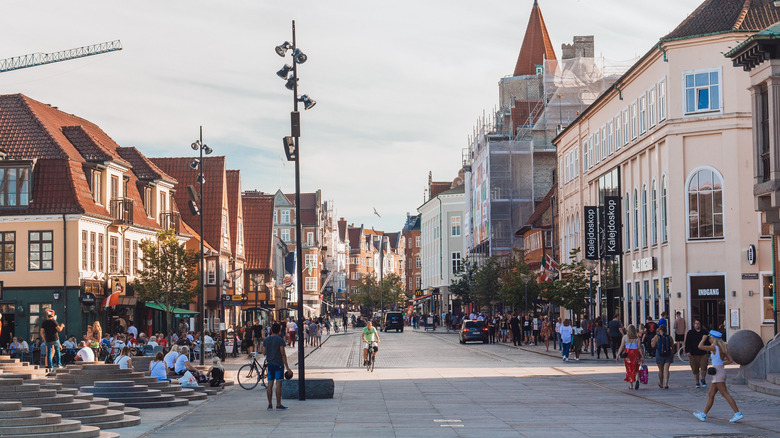The Overlooked Town In Denmark That's Less Touristy Than Copenhagen And Just As Charming
Amid the soft sands and wind-whipped hills of the Jutland Peninsula, the northerly Danish metropolis of Aalborg sits on the brim of the Baltic. The city, the fourth largest in the country, was formerly dominated by industry and known for its many smoking chimneys. Aalborg transformed drastically in the late 20th century, and the warehouses that once hauled fish and tinned preserves now house trendy bars and restaurants favored by its youthful population. Escape the crowds and high costs of Copenhagen by planning a route through Denmark's smaller, decidedly non-touristic city.
Aalborg is easily explored on foot or by bike. Eco-conscious visitors to Denmark can trundle over the cobbles and along the banks of the Limfjord strait by renting a bicycle or making use of the comprehensive local public transport. To catch the best conditions for exploring on foot or via two wheels, visit during the summer. Between May and September, the weather is warm and mostly dry, and the city's student vibe survives through the summer shoulder months.
What to do in Aalborg, Denmark
Experience the new and the old in the rapidly evolving Scandi city, flitting between post-industrial architecture, contemporary galleries, and ancient sites. A variety of tours running across Aalborg take travelers to museums jam-packed with medieval artifacts, to the homes of hunted witches, or to watch the story of the city unfold in its elaborate street art. Tourists who prefer to explore independently should wander through the eclectic works on display at the Kunsten Museum of Modern Art or venture out further from the city center to the waters of Vestre Fjordpark. Oriented around a large, natural swimming pool, a chilling dip can be followed up by lounging on the surrounding lawns, kayaking on the open waters, or playing a game of beach volleyball.
Only a 10-minute drive from the city center you'll find one of Denmark's most important historic sites, Lindholm Høje, an open-air museum containing 682 graves and 150 stone ships. The burial ground was active through the Viking Age and the Germanic Iron Age, and its accompanying museum exhibition gives visitors insights into 600 years of day-to-day Danish life. Several other Viking strongholds fortified the Jutland coast, and the vestiges of several of the 1000-year-old fortresses can still be visited on a day trip from Aalborg. Visit the Fyrkat Viking Museum, a construct of the famed and fearsome King Harald Bluetooth, to learn about the legacy of the Vikings in a UNESCO-designated World Heritage site.
Where to sleep, eat, and drink in Aalborg
Gain a true understanding of the Danish concept of hygge, the cozy sense of comfort that is integral to daily life in Denmark, by indulging in hearty Danish dishes. Order a selection of traditional smørrebrøds (sourdough rye bread layered with spreads, pickles, tinned fish, and deli meats) at the popular Hos Isidor Henius or the Utzon Center's Restaurant JØRN. Filling traditional dishes are a must before embarking on the Aalborg BeerWalk, a self-guided pub crawl available year round. Revelers can buy a ticket for 159 DKK, which includes vouchers for six specialty beers and a guide to the pubs and breweries included in the route.
Sleep close to the city's best attractions at Comwell Hvide Hus, a sleek and stylish stay with sweeping aerial urban views from the upper floors. Alternatively, opt for a night in the quaint Skovbakken's Bed & Breakfast. An affordable option in the upmarket neighborhood of Hasseris, the rooms are accompanied by a terrace garden outside the grand home.


